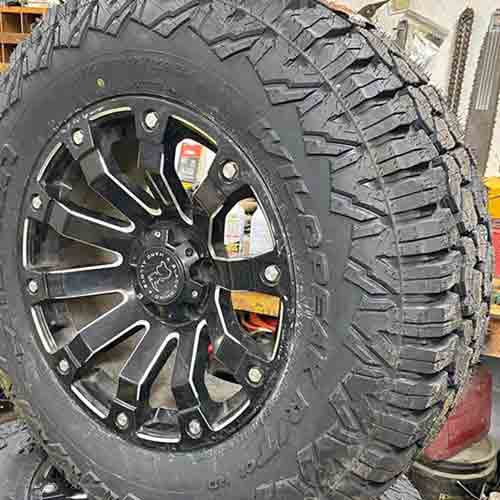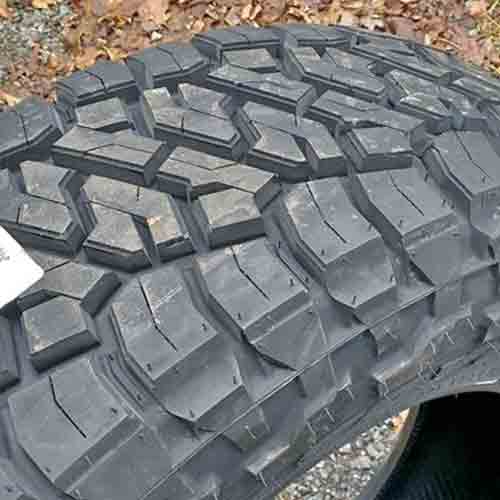Both the Falken Wildpeak RT and the Toyo Open Country R/T Trail are rugged terrain tires, as they comes between all terrain and mud terrain. Such tires are also called hybrid, as they offer you with a combination of features form both categories. Let’s check out these tires in details.

Key Takeaway
Toyo Open Country R/T Trail excels in:
- Dry Grip: Achieves shorter braking distances, showcasing superior directional grip due to its consistent rubber-to-road contact.
- Handling Stability: Outperforms the Falken Wildpeak RT due to fewer lateral voids and a more balanced weight, ensuring a more stable ride.
- Noise: Exhibits superior road quietness, largely due to its pitch sequencing and reduced in-groove resonance.
- Fuel Efficiency: Lighter weight and shallower tread depth contribute to its enhanced fuel efficiency.
- Sand Traction: Lighter weight and a larger footprint ensure increased rubber-to-sand contact, making it superior in sandy terrains.
While the Wildpeak RT excels in:
- Wet Traction: Offers a slightly better performance in wet conditions due to its softer rubber composition.
- Hydroplaning: Exhibits superior water channeling, reducing the risks of hydroplaning.
- Winter Performance: Superior in moderately deep and compacted snow conditions due to its siping design and softer compound.
- Tread Wear: Despite a softer rubber composition, the greater tread depth ensures longer mileage.
- Mud Traction: Offers faster mud evacuation due to more spaced up tread voids.
- Traction on Rocks: The lugs with greater tread depth and more biting edges provide enhanced grip on rocky terrains.
Side Note: Feeling lost, with so many all terrain options? Well, I’ve got a prefect place for you to start here, check this out: https://tiredriver.com/all-terrain-tires/
On Road Performance
Hybrid terrain tires often trade off on-road traction in favor of off-road abilities. However, with these two particular tires, the compromise is minimal, as both offer an expertly designed tread pattern, ensuring a commendable amount of rubber-to-road contact.
Let’s see how well they performed, looking at factors such as grip, and handling.
Dry Grip
Dry road conditions present various challenges to tire grip, where factors such as the weight of the tire, the composition of its tread, its rolling resistance, and the design of the central tread region are the most important ones.
And given these considerations, it becomes evident why the Toyo Open Country R/T Trail achieves shorter braking distances, an indicator of superior directional grip.

Simply put, the tire excels in ensuring greater and a more consistent rubber-to-road contact, translating to enhanced grip.
On the other side, the Falken Wildpeak RT with greater tread voids does not offer as much of the rubber to road contact, marginally diminishing its grip.
Handling Stability
When discussing handling, the tire’s sidewalls and shoulders are of primary concern. That’s why it makes sense why the Toyo Open Country R/T Trail slightly edges out its competitor.
Even though both tires exhibit subtle tread features the Falken Wildpeak RT falls a tad short due to its more pronounced lateral voids, greater weight and tread depth (on average).
Basically as the tire corners, the bulk of their weight (it carries) gets emphasized on their sides/shoulder lugs, and with greater weight and tread depth, the blocks on Wildpeak RT flex a lot more comparatively.
This bending of the lugs causes a limited overall steering response, compromising overall tire’s handling capabilities, whereas on Toyo you get a more stable ride.
Wet Performance
When navigating wet terrains, two primary concerns arise: traction and hydroplaning. Let’s delve into each of these in turn.
Wet Traction
Although both tires present considerable room for improvement in siping, and hence leave something to be desired in wet traction, the Falken Wildpeak RT manages to pull ahead with a slightly more appreciable performance.
But why is that, even though both tires do not offer full depth siping?
Well this edge is attributed to Wildpeak RT’s softer rubber composition. Where in contrast, the Toyo Open Country R/T Trail with its more rigid rubber does not allow lugs to flex better (which aids in dispersing water off).
Hydroplaning
Hydroplaning occurs when a tire is unable to maintain grip due to standing water, leading it to essentially “float” on the watery surface.
That’s why tires with ample void in their treads typically fare better in such conditions, as these voids provide significant space for rapid water evacuation.
And this very principle highlights the superior performance of the Falken Wildpeak RT, where its more expansive voided design ensures faster water channeling, leaving less work for the sipes (enhancing wet traction further), and, consequently, reducing the risks of hydroplaning.
Winter Performance
Winter terrains, particularly with snow, present varying challenges. I mean there’s ice, then there’s on-road snow, and then there are soft thick snowy terrains.
And in these snowy landscapes, the Wildpeak RT stands out, especially in moderately deep and compacted snow conditions, while both tires aren’t so great on packed up or icy terrains.
But why?
Well, because, unlike the Toyo, this tire offers a combination of thick and narrow siping slits and they work together to provide a better snow holding properties. This then offers a superior snow to snow contact, which is significant as snow particles stick to one another with greater friction compared to rubber.
Moreover, Falken RT with its softer compound also offers better thermal adaptability, meaning with freezing temperatures it’s lugs don’t get stiffen up too much, compared to Toyo RT Trail.
Noise
Noise in tires predominantly arises from air particles colliding with the walls of the tread. And those air particles majorly enter through the shoulder voids (for the most part).
That’s why out of both tires, it’s understandable why the Falken Wildpeak RT, with its pronounced lateral gaps, emits more noise.
And yes, while both tires incorporate variable pitch technology, the Toyo Open Country R/T Trail showcasing superior pitch sequencing, also offer further road quietness.
It’s tread with more rigidity does not create as much of the in-groove resonance in the first place, and with varying block geometry, the sound-waves created by air particles striking is further diminished, (as they create different tones which try to cancel out each others’ frequencies).
Fuel Efficiency
Fuel consumption is intricately tied to a tire’s rolling resistance, that’s why the heftier Falken Wildpeak RT exerts greater pressure on its tread, causing greater lug bending/flexing, which in return asks for more fuel to move.
On the flip side, the Toyo Open Country R/T Trail, being lighter across nearly all dimensions, exhibits a more effortless roll, contributing to its enhanced fuel efficiency.
And yes, like already mentioned in the handling section, it’s shallower tread depth and rigid tread rubber minimize the overall bending of the blocks, saving up energy.
Tread Wear
Like the fuel economy the overall tread life is also influenced by the tire’s rolling resistance. And it makes sense, because greater the rolling friction, greater the wear rate.
But the thing is there’s one more factor here, tread depth. And this allows the Falken Wildpeak RT to still show up with better overall mileage, in comparison.
Even though the tire offers a softer rubber composition, it’s tread depth going up to 22/32″ still takes more time to reach down to 2/32″ replacement levels.
That’s why you get 5k more miles warranty on Falken.
Off Road Performance
Navigating off-road terrains demands tires of utmost resilience and adaptability, given the multitude of challenges each terrain type presents.
Let’s discuss all these terrain types.
Mud traction
On mud, you need two things, faster evacuation, and paddling abilities. And although both of these tires with these qualities, offer superb performance here, you’d still see Wildpeak RT pulling out ahead a bit more (literally).
This is because the tire offers a more spaced up tread voids, having a greater depth to them. So mud is escaped out faster compared to Toyo.
On the other side, the Open Country R/T Trail although falls short in that regard, its just as thick sidewall lugs and staggered shoulders offers equal mud scooping abilities compared to Falken. So its performance is also not that bad after all.
Sand Traction
Sandy terrains favor lightweight tires, particularly when navigating inclined surfaces. So the Toyo Open Country R/T Trail, being lighter, excels here.
And yes, since it also offers a greater footprint on sand (which is also another vital factor here), it emerges superior with an increased rubber-to-sand contact.
Traction on Rocks
Tires for rocky terrains need to be tough, and they should offer lots of grip (in all directions).
Now in terms of grip, the Falken Wildpeak RT gives superior performance, with its more biting lugs, and a softer tread compound that adheres to the rocky surface with greater friction.
Simply put, the lugs with greater tread depth, and more biting edges simply bite the rocky surface with more power compared to Toyo RT Trail.
Though durability wise, both tires are similar.
To Sum Things Up
In conclusion, the Falken Wildpeak RT and the Toyo Open Country R/T Trail each present distinct advantages tailored to different terrains and conditions.
While the Falken leans more towards superior off-road and wet performances, the Toyo stands out in dry grip, handling, and efficiency.
Your choice between these two rugged terrain tires should hinge on your specific driving habits, terrains you frequently navigate, and the features you prioritize.
Both options represent a robust blend of design and functionality, ensuring a commendable ride no matter your selection.
How would you compare the Falken Wildpeak RT to the Falken Wildpeak AT3W? Particularly in snow and ice?
I’ve basically decided on the AT3W for my Ford F250, but am contemplating something slightly more aggressive.
The Falken Wildpeak RT and the AT3W are both excellent choices, but they cater to slightly different needs. The AT3W is known for its superior performance in snow and ice conditions, offering a good balance between off-road capability and on-road comfort. And the RT offer superior mud, sand rock and gravel performance.
When pricing the 37/12.5/17 tires on both the Falken Wildpeak RT & Toyo Open Country RT tires, the Toyo Open Country RT tires are less per tire. For (5) tires that comes out less than the Falken Wildpeak RT. Looking at current Falken tire prices they have upped the pricing on the Wildpeak 37″ tires compared to their AT & MT tire lines. Also the 38/13.5/17 Falken Wildpeak RT are less the 37/12.5/17 tires, I don’t want to go to 13.5 tires. At current prices I will be looking at other brands than the 37″ Falken Wildpeak RT.
Thanks for sharing.
I’d love to see an RT/Hybrid comparison between all manufacturers. Please include the baja boss AT. (I know, it’s classified as an AT but we all know it’s a Hybrid)
Already published those. You can find them with the search bar feature here.